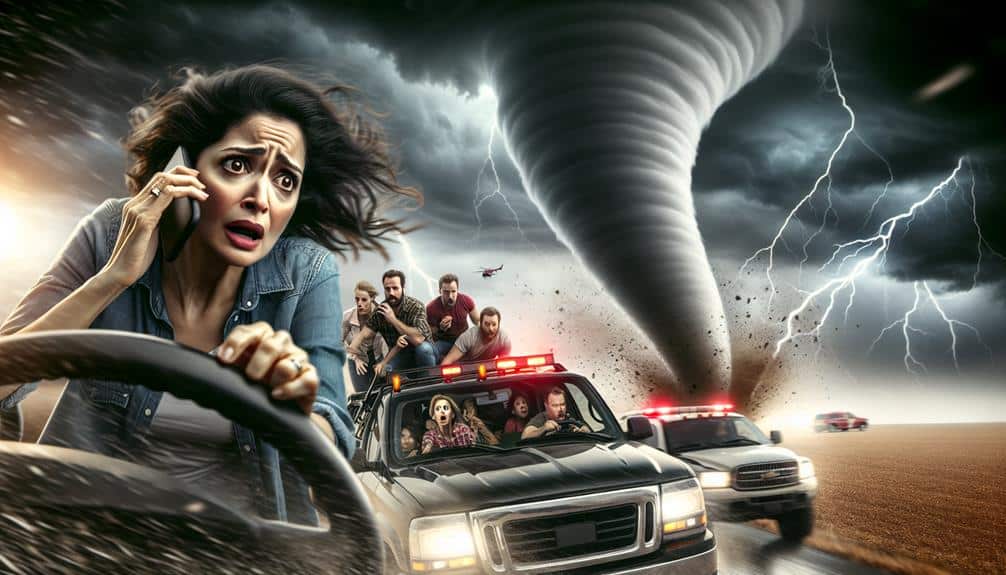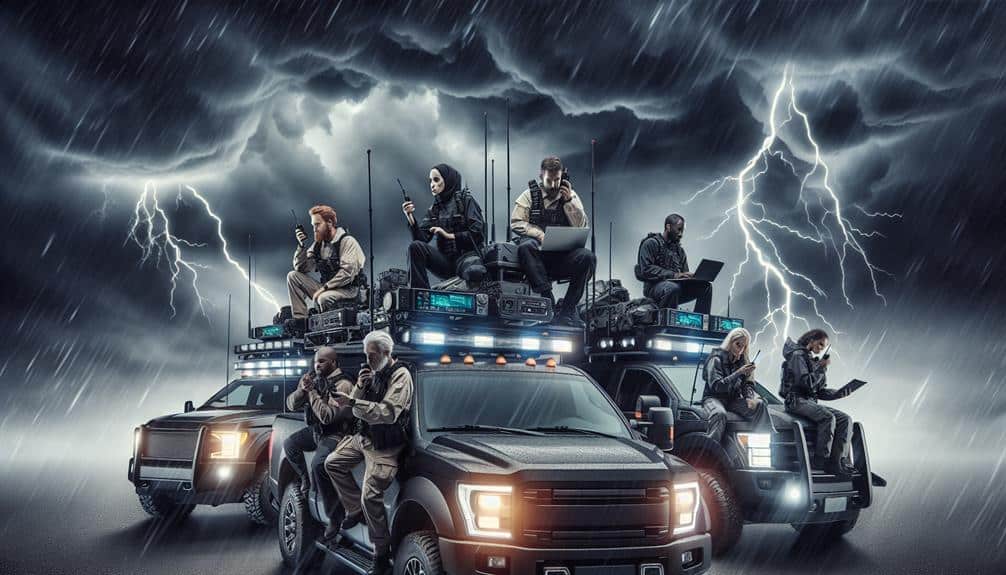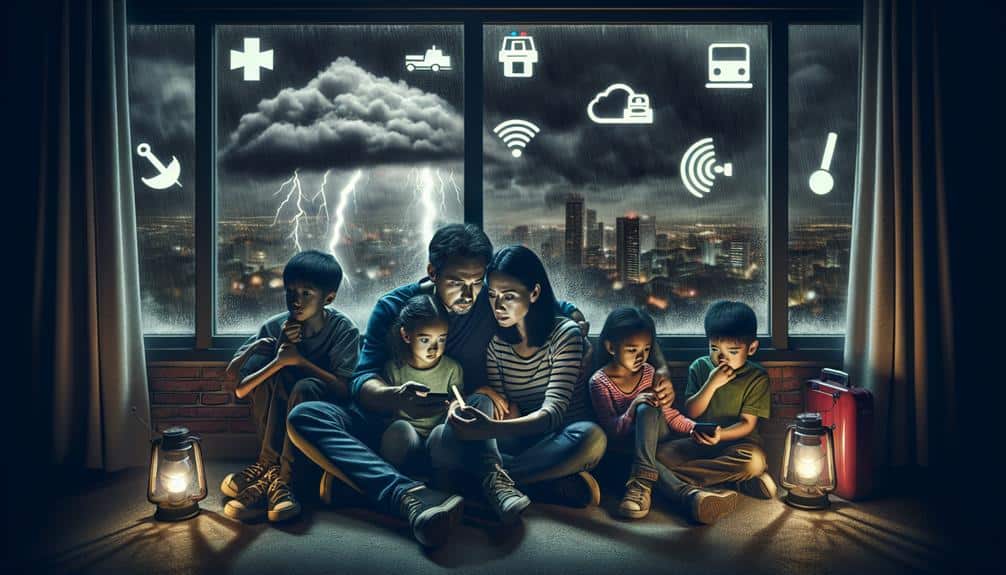Creating emergency communication plans for storm chaser teams requires a systematic approach. We begin by identifying a clear communication hierarchy that includes all key contacts, such as the team leader and logistics coordinator, ensuring everyone knows their roles. We then establish strong communication channels using reliable devices like satellite phones and high-frequency radios. Our protocols should define primary and secondary channels based on the severity of situations. Regular training and drills are essential to keeping the team prepared and proficient. By coordinating with local authorities and testing our systems frequently, we maintain a proactive safety stance. For a thorough strategy, more specifics await.
Key Points
- Establish a communication hierarchy and identify key contacts such as the team leader, communications officer, and logistics coordinator.
- Choose reliable communication devices with strong signal strength, durability, and built-in signal boosters like satellite phones and high-frequency radios.
- Define clear roles and responsibilities for team members, and establish primary and secondary communication protocols based on situation severity.
- Conduct regular drills simulating storm scenarios to train team members, focusing on communication equipment operation and emergency response.
Identifying Key Contacts
Identifying key contacts in an emergency communication plan requires a detailed analysis of who holds critical information and decision-making authority. We must first outline a robust communication hierarchy. This hierarchy guarantees that every team member knows exactly who to contact during various scenarios.
Our first emergency contact should be the team leader, who typically holds the highest decision-making power. They've the most extensive view of the situation and can make quick, informed decisions.
Next in line, we should identify a communications officer. This person is responsible for relaying information to and from the team, making sure that messages are clear and concise.
We must also consider a logistics coordinator as a key contact. This individual manages resources, transportation, and shelter arrangements. Having someone in this role allows us to focus on immediate safety concerns while knowing logistical details are handled.
Additionally, we need to include local emergency services in our contact list. Establishing a direct line with local authorities guarantees we can quickly access external aid if necessary.
Establishing Communication Channels
In establishing our communication channels, we must first choose reliable devices that can withstand severe weather conditions and guarantee constant connectivity.
Next, we need to set up clear protocols for usage, ensuring every team member knows how and when to communicate critical information.
Choosing Reliable Devices
Selecting reliable communication devices is crucial for guaranteeing seamless coordination and safety among storm chaser teams during extreme weather events. When choosing our devices, we need to prioritize device compatibility to guarantee all team members can communicate without technical barriers. Cross-compatibility between radios, smartphones, and satellite devices allows for flexible and efficient communication, regardless of the situation.
Signal strength is another critical factor. We must opt for devices that maintain strong signals in remote and storm-affected areas. Satellite phones and high-frequency radios are often the best choices, as they provide robust connectivity even when traditional networks fail.
Additionally, devices with built-in signal boosters can help maintain clear communication lines, which is crucial when maneuvering dangerous weather patterns.
We should also consider the durability and battery life of our communication tools. Devices that are water-resistant, shockproof, and have long battery lives ensure they remain functional in harsh conditions.
Setting Up Protocols
To guarantee effective communication, we must establish clear protocols that define specific channels for different types of information and emergencies. First, we need to set up primary and secondary communication channels. Our primary channel should be a dedicated radio frequency for real-time updates and immediate emergency response. Secondary channels, like mobile apps and satellite communication, serve as backups when primary systems fail.
We should also categorize our communication channels based on the severity of the situation. For day-to-day operations, we can use standard mobile networks and messaging apps. During heightened alert phases, we should switch to more robust, reliable systems like satellite phones or encrypted radio frequencies to assure uninterrupted communication.
In our crisis management strategy, we need to designate roles and responsibilities. Each team member should know who to contact for specific types of emergencies. For example, meteorologists might handle data analysis while logistics coordinators manage resource allocation. This division guarantees that information flows smoothly and efficiently, reducing confusion during critical moments.
Lastly, regular drills and training sessions are essential. They help us familiarize ourselves with these protocols and secure everyone is comfortable using all communication channels, thereby enhancing our overall emergency response capabilities.
Setting Up Protocols
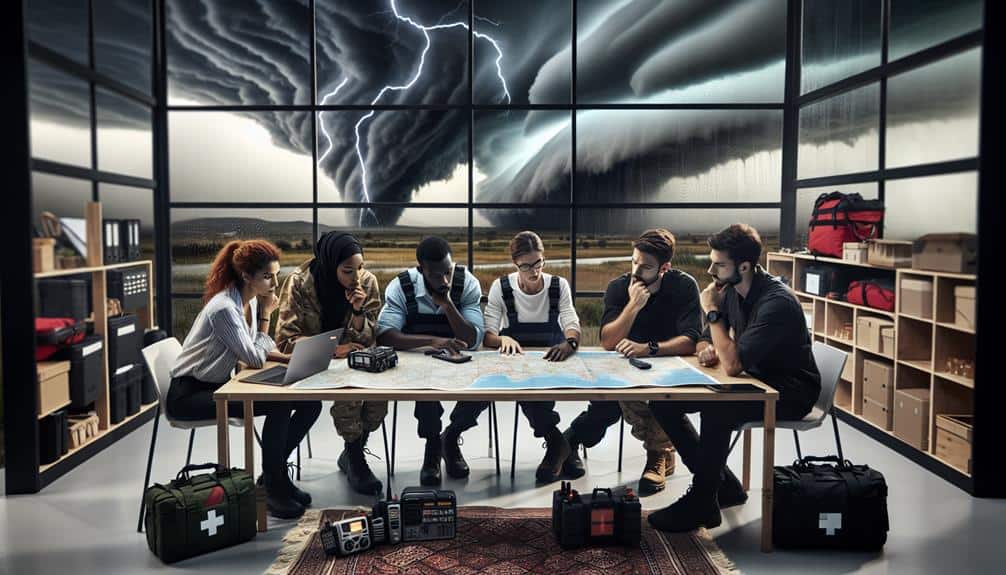
Establishing clear and thorough protocols is vital for ensuring effective communication and safety within storm chaser teams. Our first step in establishing protocols involves defining roles and responsibilities. Each team member must know their specific tasks, whether it's guiding, analyzing weather data, or handling communication equipment. This clarity enhances team coordination and minimizes confusion during high-pressure situations.
Next, we need to outline communication channels. We'll designate primary and secondary methods of communication, such as radios and satellite phones, ensuring redundancy in case one fails. It's critical to establish who contacts whom and under what circumstances, creating a streamlined flow of information. For instance, the lead chaser should have direct contact with all team members, while support staff may relay information through a designated coordinator.
We also have to set protocols for emergency scenarios. This includes pre-determined meeting points and fallback locations if separated, and clear guidelines on when to abandon a chase for safety. Additionally, we'll establish a check-in system where each member regularly confirms their status, ensuring everyone's accounted for at all times.
Training Team Members
Training team members effectively is crucial for guaranteeing they can execute their roles with confidence and precision during storm chasing operations. First, let's focus on team preparation and emergency response. We need to conduct regular training drills that simulate real-world storm scenarios. These drills should cover all aspects of the operation, from tracking storm movements to executing evacuation plans. By practicing under controlled conditions, we can identify weaknesses and improve our strategies.
Skill development is another pivotal component. Each member must master specific tasks, whether it's operating communication equipment, driving in severe weather, or interpreting meteorological data. We should set up workshops and hands-on sessions where members can hone these skills. Additionally, cross-training is crucial so that everyone has a basic understanding of each role, ensuring flexibility and redundancy in our operations.
Team coordination is the glue that holds everything together. Clear, concise communication during a storm chase is non-negotiable. We should practice using our communication protocols until they become second nature. Role-playing exercises can help us understand each other's responsibilities and reactions, fostering a cohesive unit capable of swift, effective decision-making under pressure. This way, we guarantee our readiness for any emergency.
Testing Communication Systems
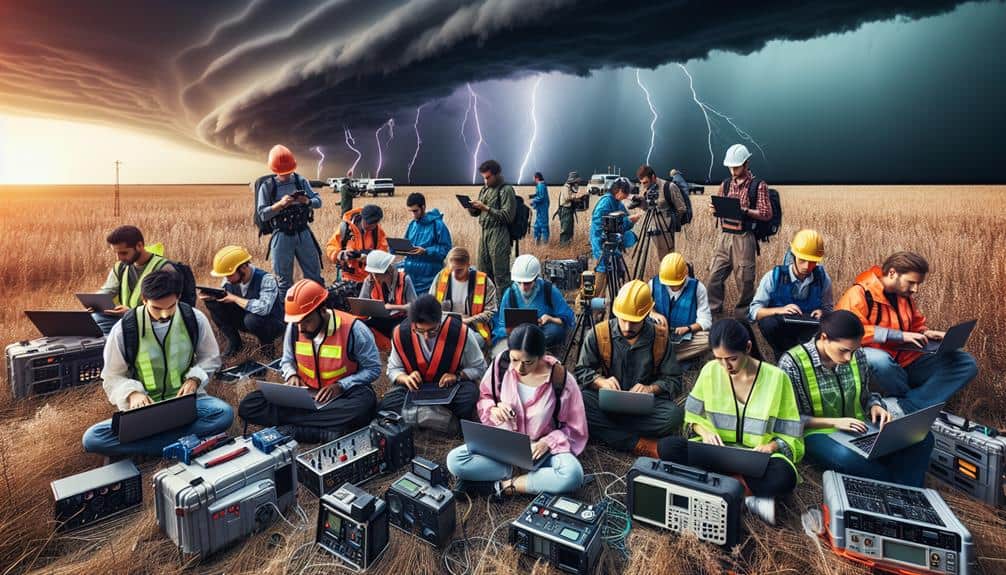
We'll guarantee our communication systems are reliable by conducting regular system check-ups and engaging in simulated emergency drills.
These practices help us identify and resolve potential issues before they become critical.
Regular System Check-Ups
Conducting regular system inspections ensures our communication systems remain reliable and effective during storm-chasing missions. By performing thorough system maintenance, we can identify and resolve potential issues before they escalate into major problems. This includes checking the integrity of our hardware, making sure our software is up-to-date, and verifying that all connections are secure.
Regular system inspections also involve routine equipment updates. Technology evolves rapidly, and staying current with the latest advancements guarantees that we've the best possible tools at our disposal. This might mean upgrading our radios, enhancing our GPS systems, or incorporating new communication software that offers improved functionality.
We should also meticulously document every system inspection. Keeping detailed logs allows us to track the history of our equipment's performance and anticipate when future maintenance or replacements might be necessary.
In addition, it's crucial to conduct these inspections under various conditions to simulate the diverse environments we might encounter. This not only tests the resilience of our systems but also helps us understand their limitations.
Thorough system inspections empower us to face the unpredictable nature of storm chasing with confidence and clarity.
Simulated Emergency Drills
Simulated emergency drills, which rigorously test our communication systems, are essential for guaranteeing we can effectively coordinate during high-stress storm-chasing scenarios. These drills help us identify and rectify weaknesses in our team response, making our operational readiness more robust. We meticulously craft each scenario, guaranteeing it reflects the unpredictability and intensity of real-life situations.
Our scenario preparation involves creating various storm events, such as tornado outbreaks or severe thunderstorms, complete with communication breakdowns and equipment failures. This allows us to evaluate how well our team adapts under pressure. We prioritize realism, integrating unexpected variables that test our team's ability to think on their feet.
During these drills, we monitor every aspect of our communication systems, from radio clarity to digital message latency. Each team member's role is scrutinized to guarantee that information flows seamlessly from storm spotters to meteorologists and support units. We also practice alternative communication methods to prepare for technology failures.
Coordinating With Authorities
Effective coordination with local and state authorities is essential for storm chaser teams to guarantee safety and operational efficiency during severe weather events. Without seamless emergency response, our ability to provide real-time data and secure team safety could be compromised. Coordination with authorities ensures we've the latest weather updates and can implement necessary safety measures promptly.
First, establishing direct communication channels with emergency management agencies is key. We must have contacts within local police, fire departments, and state weather services. These connections allow us to receive timely alerts and updates, which inform our decisions. It also secures that authorities are aware of our locations and activities, reducing the risk of miscommunication during a crisis.
Second, participating in joint training exercises with these agencies enhances our preparedness. By understanding their protocols and integrating them with ours, we create a cohesive emergency response strategy. This mutual familiarity guarantees that in the heat of the moment, our actions complement theirs, resulting in a more effective operation.
Lastly, maintaining a proactive stance on safety measures, such as having backup communication systems and clearly defined evacuation plans, is non-negotiable. Our coordination with authorities isn't just about information exchange; it's about building a robust framework that prioritizes safety at every turn.
Frequently Asked Questions
How Do We Handle Communication Equipment Malfunction During a Storm Chase?
When chaos reigns, we must follow backup procedures and team protocols. We can't afford to lose our connection. Let's check secondary devices, use hand signals, and stick to our pre-planned communication strategies to guarantee safety.
What Are the Best Practices for Documenting Communication During a Chase?
We document communication during a chase by maintaining a detailed communication log and ensuring data backup. This enhances team accountability. Using signal boosters, we minimize disruptions, guaranteeing our logs are accurate and thorough throughout the chase.
How Can We Ensure Data Security in Our Communication Systems?
To guarantee data security in our communication systems, we'll use data encryption and secure networks. By encrypting our data and employing robust, secure networks, we prevent unauthorized access and maintain the freedom to operate safely and efficiently.
What Steps Should Be Taken if a Team Member Is Unreachable?
If a team member's unreachable, we should immediately follow our team protocols, starting with attempting all emergency contacts. We need to guarantee every step's meticulously documented and escalate to local authorities if necessary.
How Do We Manage Communication in Areas With Poor Signal Reception?
In areas with poor signal reception, we manage communication by using signal boosters and satellite phones. We establish clear communication protocols and backup plans to guarantee we stay connected and maintain our freedom to operate effectively.
